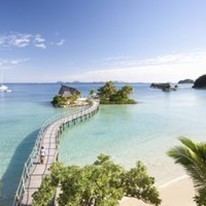Area 65 km² | Archipelago Moala Islands Length 11 km (6.8 mi) Largest settlement Naroi (pop. 550) Island group Moala Islands Adjacent body of water Koro Sea | |
 | ||
Visiting village schools in moala island
Moala is a volcanic island in the Moala subgroup of Fiji's Lau archipelago. It has an area of 62.5 square kilometers (24.1 sq mi), making it the ninth largest island of Fiji. The highest point on the island of Moala, at a maximum elevation of 468 meters (1,535 ft), is called Delaimoala which has rich vegetation and consists of dark thick forest. The population of around 3000 live in eight villages. The chiefly village of these is Naroi, whose population is over 500. Economic activities include coconut farming, cocoa production, fishing and yaqona (kava) production.
Contents
Map of Moala Island, Fiji
Oral history of the Island depicted by the genealogical records which is funded by the British through Ratu Sukuna, whose mother is from Naocovonu. The genealogical records or Vola-ni-Kawa Bula e Viti abbreviated as VKB, dictates that all Moalans are to be registered under two great sons of pre-Colonial Fiji, and these are: Kubuavanua (now claimant to the title Tui Moala) and Rovarovaivalu. This separates the Island into two sub-regions: Moala Levu (as the claimant want to call themselves) and Moala Lailai. Moala Levu include: the clan that called themselves Yavusa Ratu, and Turagalevu or Turaga Ulu), whose influence is mainly felt on the north-west of the island from Naroi to Vadra. Moala Lailai, whose village of influence once felt all over the islands from Manukui (post Colonially called Vunuku) and Wainikelei (post-Colinially referred to as Keteira). These group of Moalans are on the south and eastern end of the Island from Vunuku, Cakova and to Nasoki.
The eight village that occupy the Island is said to be for the children of Rokomautu whose sons include Rovarovaivalu, whose children in known as the "yavusa tinitini" (the clans of ten or ten clans), led by Naivalukuru. The village initially settled were Wainikelei, with later settlers being Yavusa Ratu from Verata and Yavusa Nacuritutu on their return from Tonga. The three clans settled in the bay in proximity of each others. The villages that occupy Moala was Wainikelei (post-colonial Keteira); Nasau or Korosau (Naroi); Manukui (Vunuku; Cakova and Nasoki); Nuku, Vadra, and; Maloku. The latter villages were results of tokens of war between Manukui and Nasau.
Post Colonial Fiji resulted in the relocation of Nasau to Naroi today and the resettlement of Manukui to Vunuku, Cakova and Nasoki. Other settlers came in the form of Vadra, Nuku and Maloku from other parts of Fiji as a formalisation of their effort in the last tribal war that occurred on the Island, that politicised the establishment through the effort to registration Fijians by Sukuna (Rt).
The Methodist Church is strong in Moala. Other Protestant beliefs exist in Moala today and these include: the JW's; SDA's, as well as Catholicism or relative thereof. Since the island is populated by Indigenous population, which surprisingly was not by the well known Maafu movement as depicted by some. Josaia Donumaibulu was the first laymen at the time to bring the message to the island, who was rejected by his own kin in Nasau, hence his settle with his relative in Wainikelei.
Local folk stories, well known to all, despised by any, depict that Kubunavanua came to Moala from Tonga, upon returning on the Kaunitera, thus the name, "Kubuavanua" or "Kabuavanua" (shadows of an island). "Rokomautu" (sturdy one), however remained on the island upon arrival from Totoya, on the Kaunitoni (dipping stick), on a maiden voyage approved by his father, the "Ratu". In other folk stories, the Ratu left Totoya, and made his way to now known Verata, which upon his deathbed render the race on the "nukukatudrau" (hundred fathomed beach) of his other oldest sons' to be his successor. This resulted in treachery that shook the Fijian narrative and culture to its core.
